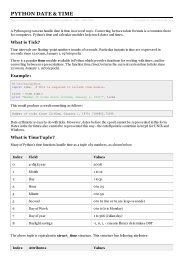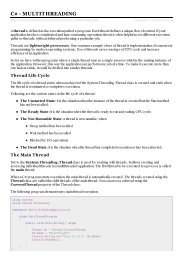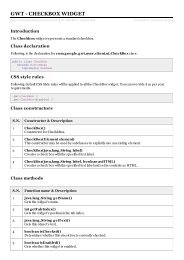Tutorials Point, Simply Easy Learning
Tutorials Point, Simply Easy Learning
Tutorials Point, Simply Easy Learning
Create successful ePaper yourself
Turn your PDF publications into a flip-book with our unique Google optimized e-Paper software.
16 | P a g e<br />
<strong>Tutorials</strong> <strong>Point</strong>, <strong>Simply</strong> <strong>Easy</strong> <strong>Learning</strong><br />
This notation is shown below and they are used to provide necessary information of a system.<br />
Relationships<br />
A model is not complete unless the relationships between elements are described properly. The<br />
Relationship gives a proper meaning to an UML model. Following are the different types of<br />
relationships available in UML.<br />
� Dependency<br />
� Association<br />
� Generalization<br />
� Extensibility<br />
Dependency Notation:<br />
Dependency is an important aspect in UML elements. It describes the dependent elements and<br />
the direction of dependency.<br />
Dependency is represented by a dotted arrow as shown below. The arrow head represents the<br />
independent element and the other end the dependent element.<br />
Dependency is used to represent dependency between two elements of a system.<br />
Association Notation:<br />
Association describes how the elements in an UML diagram are associated. In simple word it<br />
describes how many elements are taking part in an interaction.<br />
Association is represented by a dotted line with (without) arrows on both sides. The two ends<br />
represent two associated elements as shown below. The multiplicity is also mentioned at the<br />
ends (1, * etc) to show how many objects are associated.

















